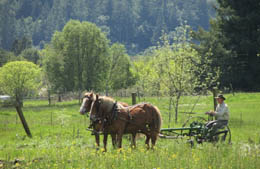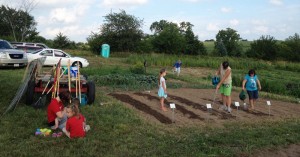Hungry for Farmland
- By Stephanie Rosenbaum
- Last Updated On
- Reading Time: 4 mins.
 Clear Spring Farm, PA.
Clear Spring Farm, PA.
If you live in an eco-conscious region fighting to preserve its local family farms, chances are you’ve seen bumper stickers such as “Know your farmer, know your food.” “I don’t buy food from strangers.” And “Who’s your farmer?” maybe on a beat-up pickup truck bringing boxes of kale to your local farmers market or on the Volvos and Priuses parked by shoppers stocking up on just-picked organic peaches.
But these catchy slogans advocate for more than just making a connection between the food we eat and the farmers who grow it. They also argue for a better life for the people who produce the food we eat.
2014 was declared the International Year of Family Farming by Director-General of the United Nations Food and Agriculture Organization (FAO), Jose Graziano da Silva, who pointed out that 70 percent of the world’s farms are family farms. And small family farms—most of which are headed by women—produce the majority of the food we eat, especially in the developing world, according to “Hungry for Farmland,” a May 2014 report produced by GRAIN, an international non-profit organization that supports small farms and biodiverse food systems.
 New Family Farm, CA.
New Family Farm, CA.
The products of these small farms often don’t show up in a country’s gross national product (GNP) the same way as grown-for-export commodity crops such as palm oil, soybeans, corn, or sugarcane. But their contribution to feeding local populations, supporting biodiversity, and keeping heirloom crops in circulation is priceless, whether it’s from growing cassava in Brazil, groundnuts in Botswana, beans in El Salvador, or apricots in Uzbekistan.
Few small farms grow just one crop; instead, they aim for producing as many vegetables, fruits, grains, or livestock as their acreage can support, relying on—and creating—ecosystems that work with, rather than against, their surrounding landscapes.
Yet the amount of arable land under cultivation by small farmers is shrinking at an alarming rate.
Want farm-fresh fruit?
We've got you covered.Land Squeeze
Facing pressure from industrialization, urban sprawl, and the enormous growth of huge single commodity-crop farms, particularly in South America and Southeast Asia, fewer and fewer small farmers have access to affordable land, forcing them to subdivide with each generation.
“We are fast losing farms and farmers through the concentration of land into the hands of the rich and powerful,” said Henk Hobbelink, coordinator of GRAIN. “The overwhelming majority of farming families today have less than two hectares to cultivate and that share is shrinking. If we do nothing to reverse this trend, the world will lose its capacity to feed itself.”
In the United States, the overall number of farms has shrunk by 30 percent in the last 50 years. Medium-sized farms have been the biggest casualties; while the number of very small farms has tripled, the number of very large farms has increased nearly six-fold.
How to Preserve Farmland
What can be done to keep crucial small farms from disappearing around the world?
 Bountiful Hope Farms, WI.
Bountiful Hope Farms, WI.
According to GRAIN’s report, a big first step is to support global rights for women, including increased independent access to credit and capital in the form of bank loans, micro-loans, and government loans. Currently, only 10 percent of such financing goes to women, although in non-industrialized countries, between 60 and 80 percent of food is grown by women.
Another crucial step is ensuring that arable farmland stays in food production. The land is valuable, and development—be it an office park, housing development, or shopping center—can often promise more return for investors than a field of potatoes. But creative solutions can make a difference. Land trusts that preserve acreage for agricultural uses, such as MALT (Marin Agricultural Land Trust), and organizations like California Farmlink, which matches landowners with farmers searching for leasing or partnerships, are two ways that valuable farmland in California is being kept under cultivation and preserved for future generations.
Want farm-fresh fruit?
We've got you covered. Two Gander Farm, PA.
Two Gander Farm, PA.
The U.S. Department of Agriculture’s “Know Your Farmer, Know Your Food” initiative offers a wide variety of programs for both farmers and consumers, all geared toward promoting successful small farming and healthy, local eating.
If you want to support small farms in your region—put your money where your mouth is: shop locally for your produce and discover the wealth of seasonal fruits and vegetables available. Surprise yourself and try something you’ve never eaten before. And most of all, get to know your farmers—and encourage your friends and neighbors to do the same.
Stephanie Rosenbaum Klassen is the author of 6 books, including Honey from Flower to Table (Chronicle Books) and Fun Food: Kids in the Kitchen (Williams-Sonoma). She writes frequently about seasonal cooking and holds a certificate in ecological horticulture from the Center for Agroecology and Sustainable Food Systems at UC Santa Cruz.
Recent Articles
2025 Employee Gift Ideas: Fruit Gift Hampers and More
How Managing Less Helps Employees Take the Lead
Why Employee Appreciation Gifts Matter in 2025
Healthy Employee Appreciation Gift Ideas for Workplace Wellness
Sugar Is Out, Protein Is In: What’s Trending In Corporate Snacks
Subscribe to our Newsletter
"*" indicates required fields



